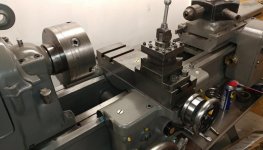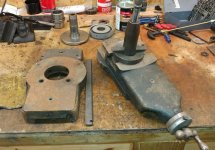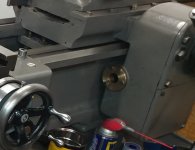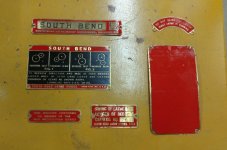texasgeartrain
Titanium
- Joined
- Feb 23, 2016
- Location
- Houston, TX
In doing my restore of my 16x6 turret lathe here:
http://www.practicalmachinist.com/v...no-2-h-turret-lathe-16-x6-restoration-317814/
I have three compound options:
1)The original turret type, with t slots for turret tool holder
2)A toolroom type, with lantern post I got off ebay, missing the chip guard extension for compound, but keeping my open.
3)Taper attachment type, which compound/lantern post would be similar as toolroom type. This one I am considering stealing from my 2nd machine, to which I may restore with a normal toolroom type and sell, but undecided yet.
Currently I went with the original turret type. I am thinking probably 99% of what I am going to do this will accomplish. Plus I like being able to setup 4 tools at once, and with a lever throw change to the next tool. But I am thinking I may restore and keep options 2 & 3 on the side if I need to do any angle cuts or tapers.
The taper attachment's use is obvious, and I can think of some pump and clutch shafts with tapers that I see. But I'm not sure I want all that on my machine for every use, extra complexity, more points of failure, wear or binding.
I'm not a lathe guy that's run these everyday in shop. So is it worth keeping all three types ? I can think of a couple of angle cuts where a toolroom type might be handy. But mostly I think I'll be going straight ahead or doing square cuts, The chamfer cuts I'm thinking of I should be able to use the turret type as well. Is there anything special with the toolroom type you guys are doing ? Or prefer use of one over the other ? Maybe some idea or opinion that I may be missing ?



http://www.practicalmachinist.com/v...no-2-h-turret-lathe-16-x6-restoration-317814/
I have three compound options:
1)The original turret type, with t slots for turret tool holder
2)A toolroom type, with lantern post I got off ebay, missing the chip guard extension for compound, but keeping my open.
3)Taper attachment type, which compound/lantern post would be similar as toolroom type. This one I am considering stealing from my 2nd machine, to which I may restore with a normal toolroom type and sell, but undecided yet.
Currently I went with the original turret type. I am thinking probably 99% of what I am going to do this will accomplish. Plus I like being able to setup 4 tools at once, and with a lever throw change to the next tool. But I am thinking I may restore and keep options 2 & 3 on the side if I need to do any angle cuts or tapers.
The taper attachment's use is obvious, and I can think of some pump and clutch shafts with tapers that I see. But I'm not sure I want all that on my machine for every use, extra complexity, more points of failure, wear or binding.
I'm not a lathe guy that's run these everyday in shop. So is it worth keeping all three types ? I can think of a couple of angle cuts where a toolroom type might be handy. But mostly I think I'll be going straight ahead or doing square cuts, The chamfer cuts I'm thinking of I should be able to use the turret type as well. Is there anything special with the toolroom type you guys are doing ? Or prefer use of one over the other ? Maybe some idea or opinion that I may be missing ?

















